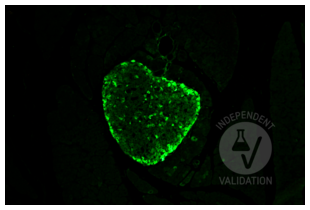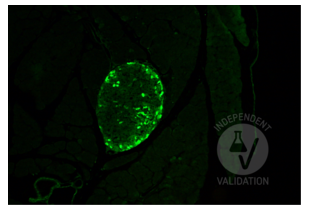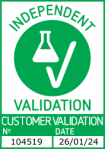Glucagon Antikörper

Kurzübersicht für Glucagon Antikörper (ABIN7448121)
Target
Alle Glucagon (GCG) Antikörper anzeigenReaktivität
Wirt
Klonalität
Konjugat
Applikation
-
-
Hersteller Produkt- Nr.
- 600-401-mv9
-
Hersteller
- Rockland
-
Verwendungszweck
- Glucagon Antibody
-
Kreuzreaktivität (Details)
- This affinity purified antibody is directed against human Glucagon.
-
Produktmerkmale
- Synonyms: Rabbit Anti-Glucagon, Pro-glucagon, Glicentin, Oxyntomodulin, OXM, OXY, Glucagon
-
Aufreinigung
- This product was affinity purified from monospecific antiserum by immunoaffinity purification.
-
Sterilität
- Sterile filtered
-
Immunogen
-
Immunogen: Glucagon antibody was prepared from whole rabbit serum produced by repeated immunizations with a synthetic peptide corresponding to an internal portion of human Glucagon.
Immunogen Type: Conjugated Peptide
-
Isotyp
- IgG
-
-
-
-
Applikationshinweise
-
Immunohistochemistry Dilution: 1:100
Application Note: Anti-Glucagon is tested in ELISA, IF, IHC, and Western Blot. Expect a band approximately ~20.9 kDa corresponding to the appropriate cell lysate or extract. Specific conditions for reactivity should be optimized by the end user.
Western Blot Dilution: User Optimized
ELISA Dilution: 1:24,800-1:44,800
IF Microscopy Dilution: 5-15 μg/mL
-
Beschränkungen
- Nur für Forschungszwecke einsetzbar
-
-
- by
- Prof. Merighi, Laboratory of Neurobiology, Department of Veterinary Sciences, University of Turin
- No.
- #104519
- Datum
- 26.01.2024
- Antigen
- Glucagon
- Chargennummer
- 49549
- Validierte Anwendung
- Immunohistochemistry
- Positivkontrolle
Adult (> 2 months) CD1 mouse pancreas fixed in 4% paraformaldehyde.
- Negativkontrolle
One control slice for each experimental procedure processed omitting the primary antibody; overnight incubation in diluent solution only.
- Bewertung
Passed. The Glucagon antibody ABIN7448121 works in IHC-P at 1:100 concentrations with microwave antigen retrieval treated sections.
- Primärantikörper
- ABIN7448121
- Sekundärantikörper
- anti-rabbit secondary antibody Alexa Fluor 488 (Thermo Fisher Scientific, A11034, lot # XJ357262)
- Full Protocol
- Perfuse mice with paraformaldehyde 4% in 0.1 M phosphate buffer pH 7.4 and post-fix of samples in the same fixative for an additional 2 h at RT.
- Wash, dehydrate, and embed samples in paraffin wax.
- Wash several times with 0.01 M PBS.
- Cut brain with a microtome into 6 µm sections and mount on glass slides.
- After paraffin removal processed sections for microwave antigen retrieval for 10 minutes (95-100° C) in 10 mM sodium citrate buffer (pH 6.0). After 20 minutes of spontaneous cooling, wash sections (distilled water, 2 times for 5 minutes each; followed by PBS for 5 minutes).
- Incubate sections for 1 h at RT in a humid chamber in PBS containing 1% ovalbumin (Sigma, A5378) and 0.3% Triton-X-100 (BioRad, 161-0407, lot 00583) to block non-specific binding sites.
- Incubate sections with primary rabbit anti- Glucagon (antibodies-online, ABIN7448121, lot 49549) diluted 1:50 and 1:100, in PBS-BSA-PLL ON at RT in a humid chamber.
- Wash sections 3x 5 min with 0.01 M PBS.
- Incubate sections with anti-rabbit secondary antibody Alexa Fluor 488 (Thermo Fisher Scientific, A11034, lot # XJ357262), 1:500, in 0.1M PBS, 1 hour at room temperature.
- Wash sections 3x 5 min in 0.01 M PBS.
- Mount specimens in Fluoroshield (Sigma, F6182, lot MKCB0153V).
- Acquire images Leica DM 6000B fluorescence microscope equipped with a digital camera at 40x magnification.
- Anmerkungen
Validierung #104519 (Immunohistochemistry)![Erfolgreich validiert 'Independent Validation' Siegel]()
![Erfolgreich validiert 'Independent Validation' Siegel]() ValidierungsbilderProtokoll
ValidierungsbilderProtokoll -
-
Format
- Liquid
-
Konzentration
- 1.18 mg/mL
-
Buffer
-
Buffer: 0.02 M Potassium Phosphate, 0.15 M Sodium Chloride, pH 7.2
Stabilizer: None
Preservative: 0.01 % (w/v) Sodium Azide -
Konservierungsmittel
- Sodium azide
-
Vorsichtsmaßnahmen
- This product contains Sodium azide: a POISONOUS AND HAZARDOUS SUBSTANCE which should be handled by trained staff only.
-
Lagerung
- 4 °C,-20 °C
-
Informationen zur Lagerung
- Store vial at -20° C prior to opening. Aliquot contents and freeze at -20° C or below for extended storage. Avoid cycles of freezing and thawing. Centrifuge product if not completely clear after standing at room temperature. This product is stable for several weeks at 4° C as an undiluted liquid. Dilute only prior to immediate use.
-
Haltbarkeit
- 12 months
-
-
- Glucagon (GCG)
-
Andere Bezeichnung
- GCG
-
Hintergrund
- Background: Glucagon is a member of a multigene family that includes secretin. Glucagon is a 29-amino acid pancreatic hormone that counteracts the glucose-lowering action of insulin by stimulating glycogenolysis and gluconeogenesis. The human glucagon gene is approximately 9.4 kb long, contains 6 exons and 5 introns, and assigned to 2q36-2q37. This antibody is suitable for researchers interested in metabolic diseases, like diabetes, cell proliferation, differentiation, apoptosis, GCPR signaling, and calcium signaling research.
-
Gen-ID
- 2641
-
NCBI Accession
- NP_002045
-
UniProt
- P01275
-
Pathways
- Positive Regulation of Peptide Hormone Secretion, Peptide Hormone Metabolism, cAMP Metabolic Process, Regulation of Carbohydrate Metabolic Process, Feeding Behaviour, Negative Regulation of intrinsic apoptotic Signaling
Target
-



 (1 Validierung)
(1 Validierung)



